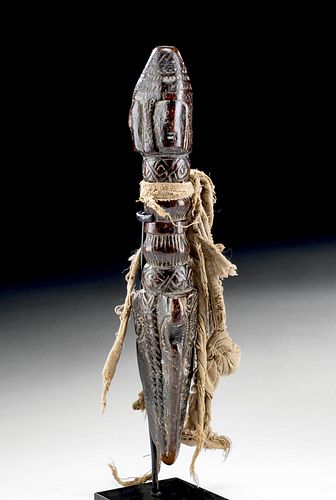19th C. Tibetan Carved Wooden Phurba / Magic Dagger
Lot 25k
About Seller
Artemis Gallery
686 S Taylor Ave, Ste 106
Louisville, CO 80027
United States
Selling antiquities, ancient and ethnographic art online since 1993, Artemis Gallery specializes in Classical Antiquities (Egyptian, Greek, Roman, Near Eastern), Asian, Pre-Columbian, African / Tribal / Oceanographic art. Our extensive inventory includes pottery, stone, metal, wood, glass and textil...Read more
Categories
Estimate:
$1,000 - $1,500
Absentee vs Live bid
Two ways to bid:
- Leave a max absentee bid and the platform will bid on your behalf up to your maximum bid during the live auction.
- Bid live during the auction and your bids will be submitted real-time to the auctioneer.
Bid Increments
| Price | Bid Increment |
|---|---|
| $0 | $25 |
| $300 | $50 |
| $1,000 | $100 |
| $2,000 | $250 |
| $5,000 | $500 |
| $10,000 | $1,000 |
| $20,000 | $2,500 |
| $50,000 | $5,000 |
| $100,000 | $10,000 |
| $200,000 | $20,000 |
About Auction
By Artemis Gallery
Jun 24, 2021
Set Reminder
2021-06-24 10:00:00
2021-06-24 10:00:00
America/New_York
Bidsquare
Bidsquare : VARIETY SALE | Ancient & Ethnographic Art
https://www.bidsquare.com/auctions/artemis-gallery/variety-sale-ancient-ethnographic-art-7119
Featuring classical antiquities, ancient and ethnographic art. Egyptian, Greek, Roman, Etruscan, Near Eastern, Asian, Pre-Columbian, Native American, African / Tribal, Oceanic, Spanish Colonial, Russian, Fossils, Fine Art, more! All legally acquired, legal to sell. Satisfaction guaranteed. Artemis Gallery info@artemisgallery.com
Featuring classical antiquities, ancient and ethnographic art. Egyptian, Greek, Roman, Etruscan, Near Eastern, Asian, Pre-Columbian, Native American, African / Tribal, Oceanic, Spanish Colonial, Russian, Fossils, Fine Art, more! All legally acquired, legal to sell. Satisfaction guaranteed. Artemis Gallery info@artemisgallery.com
- Lot Description
Central Asia, Tibet, ca. 19th century CE. A skillfully-carved wooden phurba dagger (also known as a magic dagger) in the traditional form of a three-sided stake. Enveloped in a hue of chocolate brown with a lustrous burnish, the ceremonial weapon features a ridged handle that is corseted at its mid-section and a pointed pommel displaying three faces of the deity Mahakala. Mahakala means the "Great Black One" or "Great Time" as Kala means time. According to Meulenbeld's "Buddhist Symbolism in Tibetan Thangkas" (2004), "Time is seen as the destroyer of everything and everyone, and therefore equated with death. On the one hand time is eternal, without beginning or end, always continuing. On the other, this eternity consists of little portions of time that are finite, like human life." A beautiful incised motif of an abstract design decorates the entirety of the piece's exterior, while a tan cloth with seven extended strands is tied around its handle. Size: 1.375" W x 8.375" H (3.5 cm x 21.3 cm); 9.25" H (23.5 cm) on included custom stand.
Phurbas are known to symbolize peace and stability, and are thought to keep demons in their place. Only shamans or special individuals empowered to use a phurba are permitted to use it in ritualistic ceremonies. The blade on the phurba is never actually sharp, as it is a ritual dagger rather than a weapon intended to bring about destruction. Padmasambhava is widely regarded as the inventor of the phurba. In the 8th century, Padmasambhava used the phurba to consecrate the ground when he established the Samye monastery. Interestingly, tents have always played significant roles in Tibet as Tibet has always been a nomadic culture, and inserting tent pegs has been interpreted as sacrificing the earth. Hence, the shape of the phurba may derive from the stake used to secure tents.
In order to use a phurba, practitioners begin with meditation, then recite the sadhana of the phurba, inviting the deity to enter the phurba. The shaman then stabs the phurba into the ground, or into a bowl of rice/grain, all the while envisioning that the evil spirits or negative energies are beneath the blade. Phurbas are also traditionally used as decorations in homes and temples, and many practitioners include phurbas in their meditation rooms.
Dorje Phurba also known as Vajrakilaya, who is the wrathful form of Vajrapani (one of the wrathful deities known to remove obstacles) used the phurba. One can oftentimes see Vajrakilaya holding the phurba on Buddhist statues and thangkas. Vajrakilaya's consort is Khorlo Gyedunma, a manifestation of the Green Tara. When a vajra is held in the upraised right hand of Vajrapani assuming his wrathful form, it is interpreted as a weapon, akin to Zeus' lightning bold or Hercules' club.
Provenance: private New York, New York, USA collection
All items legal to buy/sell under U.S. Statute covering cultural patrimony Code 2600, CHAPTER 14, and are guaranteed to be as described or your money back.
A Certificate of Authenticity will accompany all winning bids.
We ship worldwide and handle all shipping in-house for your convenience.
#161311Some softening of incised detail and light fraying to cloth. Otherwise, excellent and intact with nice earthen deposits in recessed areas.Condition
- Shipping Info
-
All shipping is handled in-house for your convenience. Your invoice from Artemis Gallery will include shipping calculation instructions. If in doubt, please inquire BEFORE bidding for estimated shipping costs for individual items.
-
- Buyer's Premium



 EUR
EUR CAD
CAD AUD
AUD GBP
GBP MXN
MXN HKD
HKD CNY
CNY MYR
MYR SEK
SEK SGD
SGD CHF
CHF THB
THB














